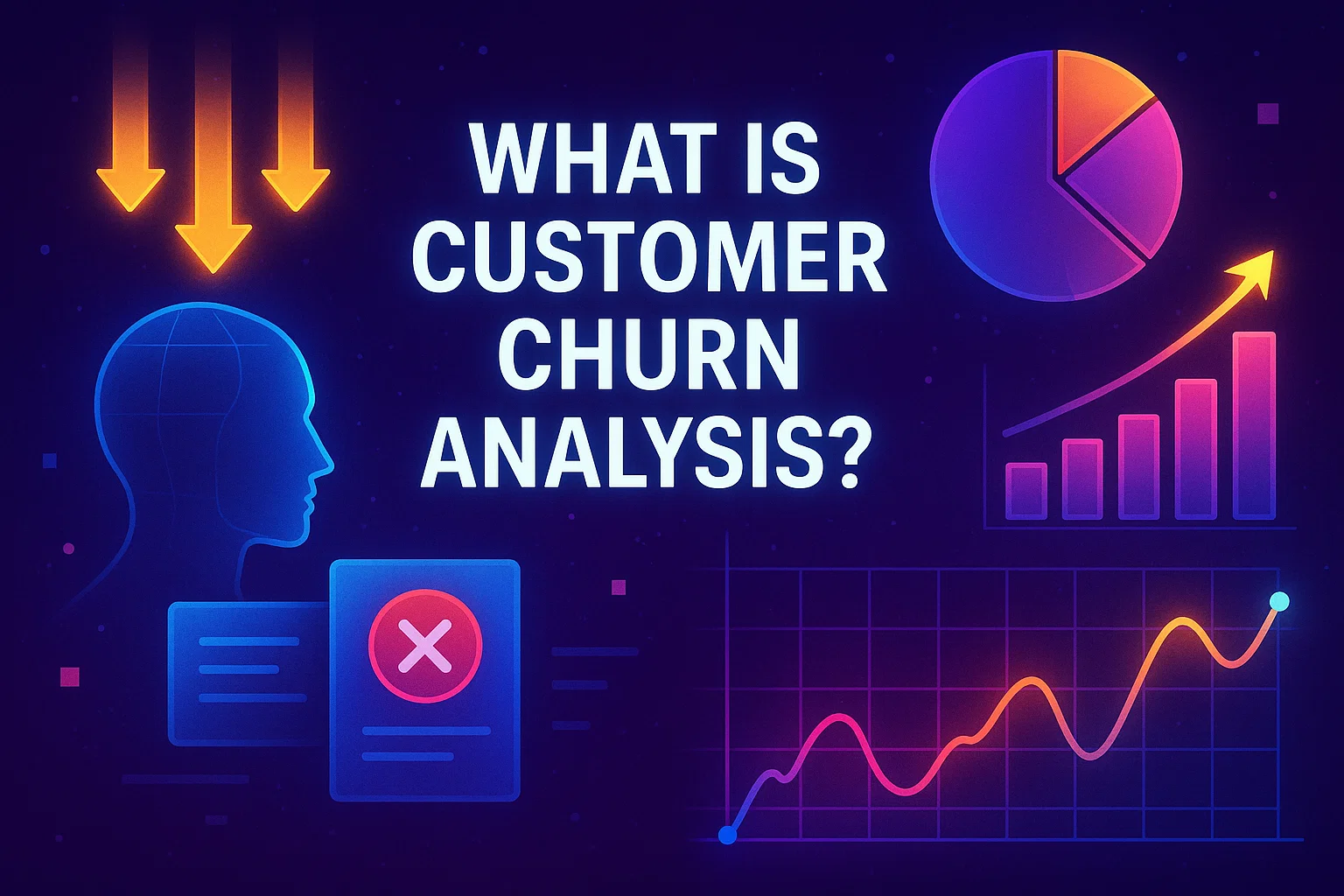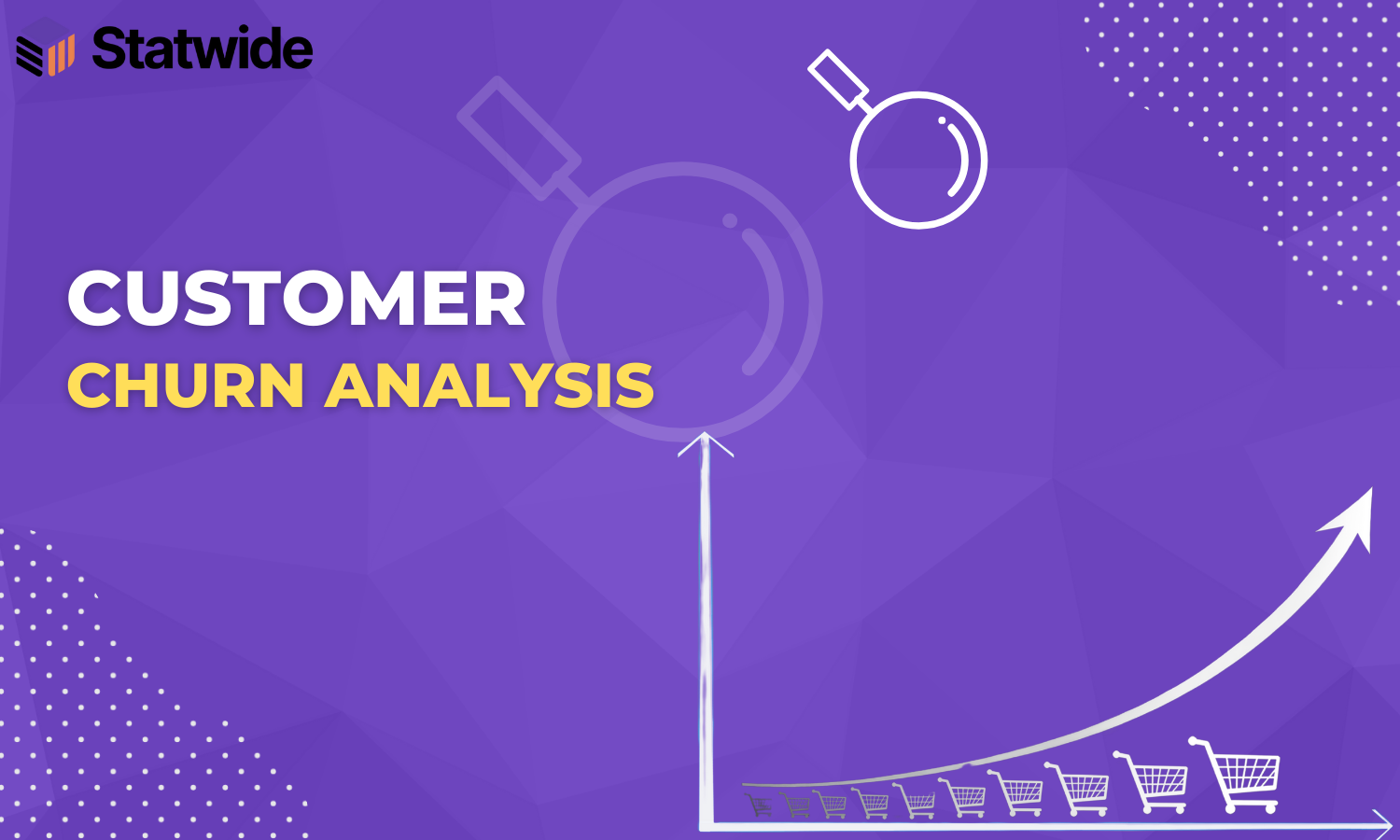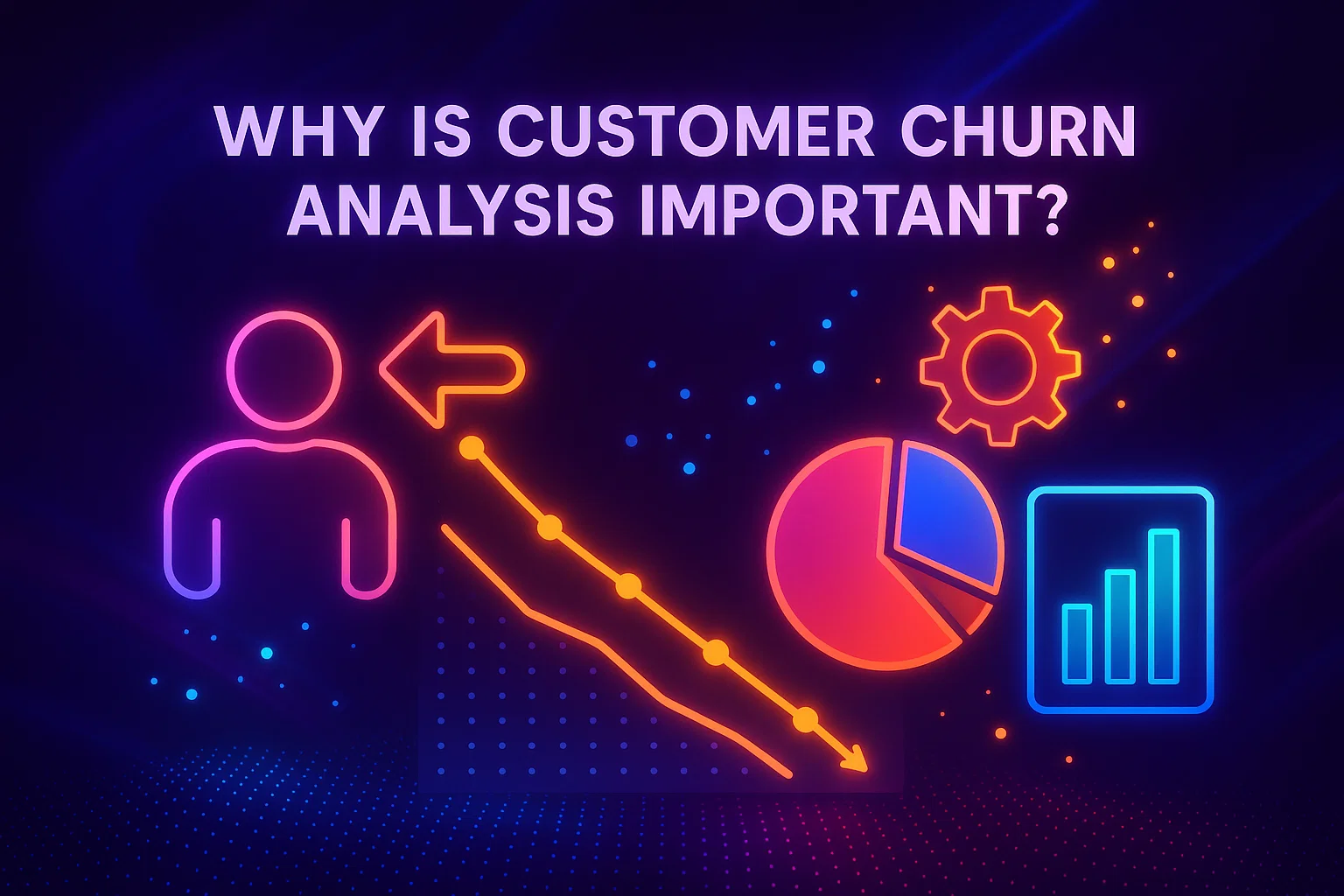Churn rate analysis is the most useful process for businesses, especially when they notice a sudden decline in retention rate. With the related issues growing, the owners often wonder why the customers choose to leave and find it essential to track the reasons behind this shift as early as possible to maintain a stable and growing customer base. Most importantly, leaving the churn rate as it is can lead to long-term revenue loss and affect overall ROI.
It is done with the collection of data analysis on the customer journey with your brand. Businesses can develop a data-driven strategy with actionable insights to improve customer relationships as well as retention rates.

What is customer churn analysis?
Customer churn analysis is the extensive process of analyzing customer behavior, transaction history, engagement patterns, feedback, and other data points to get insights into the churn. Beyond just looking at your churn rate, you are finding the major reasons why they leave the company.
For example, a proper streaming service might see users canceling their subscriptions after their free trial. Churn analysis helps them find out that the price wasn’t justified for them for limited viewing. The service then starts offering a discount on the first month after the trial ends, and can successfully retain these subscribers by reducing churn.
Why Is Customer Churn Analysis Important?
Customer churn analysis is a highly effective strategy to gain breakthrough insights into why customers leave and retention strategies for long-term growth. Let’s be more clear through the below-listed advantages:
Early Problem Detection
Churn analysis is more like an early warning system in finding out the signs of potential problems before they get worse. Research shows that up to 67% of customer churn is preventable if the related issues can be solved on time.
Increased Customer Retention
Retaining customers is the most cost-effective approach rather than trying to acquire new ones. And for that, a proper churn analysis plays a big role in the retention rate.
Higher Revenue Growth
A thorough churn rate analysis directly impacts your bottom line. By taking proactive actions from the analysis, you can ensure a stable revenue stream, reduce the acquisition cost by up to 5-25 times, and create opportunities for long-term growth.
Improved Customer Experience:
Churn analysis helps you track the pain points in the customer journey and offers opportunities to address them earlier. It not only reduces the churn rate but also improves the overall customer experience. It helps to improve your brand value in the industry.
How to Conduct a Customer Churn Analysis?
There are various ways businesses use to analyze the customer churn rate of your brand or company. Here, we are simplifying the process with only five quick steps. Check and find on your own.
Step 1: Find Key Metrics from Customer Journey
First, go through the complete customer journey, starting from purchase history, website interactions, and customer support tickets to feedback surveys to collect comprehensive data. These overall insights help you analyze the churn rate and the reasons for it. Let’s get the details from below:
i) Customer feedback surveys: Collect data from customer feedback to understand their satisfaction levels, challenges, and reasons why they leave your brand.
ii) Usage patterns: Track how your customers find your product effective in their usage journey. Low or declining usage signals the lack of your service’s value.
iii) Support tickets: Analyze your customer support system to find the reports on ticket volumes and the categories of their queries. Here, you will find the idea of mostly-faced problems.
iv) Payment history: Track your subscription management system to gather information on the customer’s payment data, including renewals, cancellations, and payment failures.
v) Demographic information: Analyze the demographic data, such as customer age, location, and account type, to know which customer segments are more likely to churn.
Step 2: Identify At-Risk Customers Through Segmentation
Next, you will divide your churned customers into a few different groups based on the key metrics you have defined above, which is known as customer segmentation. It is one of the most important processes for understanding the churn dynamics of a business.
Most businesses go for a cohort analysis to make the task easier. You can use advanced tools like Younium, Mixpanel, and Google Analytics, which offer segmentation and cohort analysis features. Here is an example of cohort analysis of a subscription-based product or app over a 12-month period.
Besides, various CRM tools like HubSpot or Salesforce have built-in segmentation features. You can use data analytics tools like SQL or Python for complex segmentation and large datasets.
Step 3: Calculate Your Churn Rate
Now, the time has come to calculate your churn rate from the basic churn data analysis. This helps you find out which customer segments are at the highest risk of leaving. Here is the simple formula to follow:
Let’s say that, for a cohort of customers, you have started your brand journey with 200 customers. After analyzing the segmented group, you have found that 20 of them left during the month.
So, Churn Rate = (20 / 200) x 100 = 10%.
That means up to 10% of customers in that segment churned.
Step 4: Find the Root Causes of Churn
Next, identify the major reasons why customers leave your company based on the churn rate for each segmentation. This way, you can take actionable steps accordingly to reduce churn. For instance, here are some of the best suggestions you can follow:
Conduct follow-up surveys with churned customers where you can ask questions like “What led to your decision to leave?”
You can set up automated alerts for customers that show signs of declining usage, such as not logging in or not using key features. The best is that, if you can, you can monitor social media platforms and online reviews to see what they are saying about your brand. Here is an example of a Social Listening Dashboard highlighting negative sentiment.
Or, you can investigate your competitors’ offerings and marketing strategies to find what has made them better.
Step 5: Take Action
According to your analysis, this is the time to take measurable steps. This involves finding ways to cover up the lacking and applying result-driven strategies to improve retention to the next level. Here are a few quick suggestions you can check out:
- Ensure personalized communication to make your customers feel valued and understood. 71% of consumers expect personalized interactions with brands.
- Offer a strong onboarding system that can increase your customer retention by up to 82%.
- Ensure personalized customer support through emails, in-app messages, or live chat. 73% of customers demand multiple channels to engage with a brand.
- Develop a platform to connect with each other, share experiences, and ask questions. You can experience 2x higher customer lifetime value through this initiative.
Data Collection for Customer Churn Analysis
To have more detailed and accurate data for churn analysis, you can choose various well-organzed CRM tools available in the online market. CRM systems are specially designed to help businesses track customer interactions, monitor engagement, and analyze behavioral patterns. Through these, you can easily identify potential churn risks and improve retention strategies.
Some effective CRM systems for churn analysis include:
1. Salesforce: It offers customizable report dashboards and data segmentation to track customer activity. Plus, with their specialized workflow automation tools, businesses can respond to at-risk customers quickly. It also helps to integrate with predictive analytics tools and make your churn analysis faster.
2. HubSpot: The tool provides contact properties so that companies can easily track customer interactions over time. With the lifecycle stage tracking, you can identify customers who are losing interest, and automated workflows help you improve your retention strategies.
3. ChurnZero: It offers customer health scoring where you can see your satisfied customers and which customers are at risk of leaving. Predictive churn alerts will notify you of the upcoming customer churn, and customer journey mapping tracks the engagement among them.
4. Zoho CRM: The tool offers AI-powered insights to track the customer overlap churn and helps businesses get smart suggestions on how to keep customers engaged. You can get advanced customer segmentation to group your customers and reports and dashboards to analyze customer activity.
What Data to Analyze for Churn Analysis?
To conduct an effective churn analysis, you need data from customer interactions, satisfaction levels, and transaction trends. At times, you will need to check account activity, satisfaction surveys, feedback, and customer health scores.
Before you get into the specifics, go for these essential checks and get a quick understanding of the data:
1. Customer Demographics & Firmographics: Go in-depth into your customer demographics and look for their age, location, gender, company size, industry, and job title to see if certain types of customers leave more often than others.
2. Customer Behavior: You need to pay attention to how much the customer interacts with your service or products. You can find them by tracking –
- How often do they visit your website?
- How long do they spend using your product or service?
- Or if they open your emails or ignore them.
3. Engagement Levels: Not only do purchases matter, but you also need to find out how long they are involved with your brand. Go through their recent inquiries or feedback to get clearer insights. Various social media interactions and customer feedback forms will help you here.
4. Transaction History: Look at how often they are buying your products. If it is your regular customer but they suddenly stop, it could be an alarming sign that they may leave soon.
Key Metrics in Customer Churn Analysis
Now, we are going to highlight some essential KPIs beyond just churn rate that help you identify at-risk customers and find the effectiveness of your retention strategies. For instance, you must check the below list:
Customer Lifetime Value (CLV):
It is the estimate of the ROI you can get from a customer to your business. Through this, you can understand the long-term value of each customer. To do this, simply follow this formula:
Customer Retention Rate (CRR):
It is the calculation of how many customers are engaged with your brand or business over a given time. It gives you a positive view of customer loyalty. To measure this rate:
Net Promoter Score (NPS):
It is the most interesting key metrics that help you measure your customer satisfaction level through insights on how much they recommend your brand to others on a scale. It is measured on three indicators: detractors, passives, and promoters.
Expert Tips for Effective Churn Analysis
Here are some effective tips you can follow to do a proper analysis of your churn rate:
- Instead of waiting for the complete churn of a customer, it is smart to analyze micro-behaviors such as reduced engagement, slower response times to emails, or shorter session durations. The subtle changes present a golden opportunity for you to address the issue earlier before churn happens.
- Note that not all churn is equal. Prioritize the factor when your high-value customers are leaving at a higher rate than your low-value customers.
- As with internal customer data, make sure to focus on external factors such as industry trends, economic conditions, and competitor movements to get the most detailed view of why customers churn.
- Beyond just focusing on active churn who leave you, it is also recommended to focus on the churn or silent churn as well. It includes some customers who like not opening emails or reducing purchases gradually.
- Based on the churn analysis, develop targeted intervention strategies like sending personalized outreach emails, offering loyalty perks, or providing exclusive discounts to prevent churn.
In Closing
Customer churn analysis is important for any business with the goal of long-term growth. With a clear understanding of customer churn and implementing proper strategies, businesses can easily improve customer experience and maximize customer lifetime value.
But one thing is more important here is that not just analyzing data will be enough unless you merge your collected data and take the appropriate action at every step of the way.
Author
Shirikant is a proven customer success leader who combines sharp business insight with practical experience to improve retention and drive revenue. As the founder of Statwide, he designs customer-first business strategies that guide companies to turn users into loyal and long-term partners. His approaches are built on real results: stronger relationships, higher customer value, and lasting growth.










